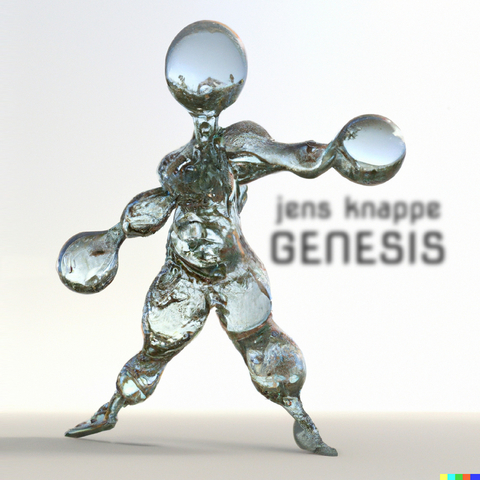Genesis
Gamut Verlag
978-3-940948-45-8 (ISBN)
DALL E 2 ist Teil des bislang erfolgreichsten Large Language Models „GPT3“ und kann daher auf einen Großteil des im Internet Veröffentlichten als „Bildungsschatz“ zurückgreifen. Was lag da näher als das System mit den großen Erzählungen, wissenschaftlichen Theorien, uralten und modernen Mythen der Menschheit und ihren Zukunftsvisionen zu füttern und zu schauen, was dabei herauskommt? GENESIS, eine subjektiv eingefärbte, auf Menschheitsmythen basierende Schöpfungsgeschichte war der Leitfaden für das Testprogramm an die KI: das vorliegende Buch ist ein Substrat dieser systematischen Herausforderung an dessen „Wissen“ und „Kreativität“.
Es ist ein Blick in eine „Black Box“, denn während man immer genauer herausfindet, mit welchen technischen Methoden sich die Leistungsfähigkeit dieser der Wirkungsweise des menschlichen Gehirns nachempfundenen, selbstlernenden neuronalen Netzwerke verbessern lassen, bleibt eine Frage im Kern unbeantwortet: Warum? Wieso werden sie besser? Warum werden Sätze, die ein Chatbot ausspuckt und nach einem Wahrscheinlichkeitsprinzip ein Wort an das andere reiht, der Kommunikation eines echten Menschen immer ähnlicher? Und zwar so sehr, dass sogar mit einer stocknüchternen, prosaischen Geistesverfassung ausgestattete Programmierer und Ingenieure in den entwickelnden Firmen zunehmend das Gefühl gewinnen, es bei ihren Computerprogrammen mit bewussten, fühlenden Wesen zu tun zu haben?
Warum ergeben die nach ebensolchen Wahrscheinlichkeitsberechnungen erzeugten Pixel, die an Pixel gesetzt werden, ein immer kohärenter und intelligenter komponiert erscheinendes Gesamtbild? Bilder, die wenige Sekunden nach der Eingabe eines beschreibenden Textes auf dem Bildschirm erscheinen und wo man sich des Eindrucks kaum entziehen kann, es auf der anderen Seite mit einem hochintelligenten und gebildeten, kreativen Gegenüber zu tun zu haben? Maschine hin oder her. Dieses Buch gibt einen Einblick in die Schöne Neue Welt der Künstlichen Kreativität.
Jens Knappe runs a photo agency and has been using systems with self-learning algorithms, with artificial intelligence, for about ten years: initially for the automatic recognition and classification of the agency's image inventory and, for some time now, also such systems that independently create CGIs (computer-generated images). Therefore, he was among the first to put OpenAI's novel "text-to-image" system DALL E 2 through rigorous testing for possible errors, potential dangers and also in view of its possibilities, before it was unleashed on humanity. From the very first images the system produced, it was clear that this was a milestone of epochal proportions, leaving its predecessors far behind. This is undoubtedly only a snapshot in an exponential, almost explosive development. But an important one. Because this is where the human claim to sole representation of creativity comes under pressure.
DALL E 2 is part of the most successful Large Language Model to date "GPT3" and therefore can draw on a large part of what has been published on the Internet as its "educational treasure". What could be more obvious than to feed the system with the grand narratives, scientific theories, ancient and modern myths and future visions of humankind and see what comes out? GENESIS, a subjectively colored creation story based on human myths, was the guideline for the test program to AI: this book is a substrate of this systematic challenge to its "knowledge" and "creativity". It is a glimpse into a "black box," since while the technical methods that can be used to improve the performance of these self-learning neural networks which mimic the human brain are being discovered with increasing precision, one question remains unanswered: Why? For what reason are they getting better? Why do the sentences that a chatbot spits out, lining up one word after another according to a probability calculation, become more and more similar to the communication of a real person? So much so, in fact, that even programmers and engineers in developing companies with a sober, prosaic state of mind are increasingly getting the feeling that their computer programs have gained consciousness and sentience.
Why do pixels generated according to just such probability calculations, placed next to other pixels, result in an overall image that appears to be ever more coherent and intelligently composed? Images that appear on the screen a few seconds after the input of a descriptive text and where one can hardly escape the impression that one is dealing with a highly intelligent and educated, creative counterpart on the other side? Machine or not. This book gives an insight into the Brave New World of Artificial Creativity.
Jens Knappe studierte Publizistik und Amerikanistik in Mainz, Moskau und Berkeley. Er hat sich akademisch so diversen Themen wie der Medienberichterstattung über den deutschen Vereinigungsprozess, Versuchen einer Gedankenkontrolle durch Sprache in der Sowjetunion zu Zeiten Stalins und den Folgen neuer technologischer Entwicklungen gewidmet. Er ist Autor der Monographien „The Nature of Cyberspace“, „Die USA und die deutsche Einheit“ sowie „Berliner Republik. Hauptstadt als Bühne“. Jens Knappe betreibt eine Bildagentur in Berlin. Jens Knappe studied Media and American Studies in Mainz, Moscow and Berkeley. His academic work deals with such diverse topics as the media coverage of the German unification process, attempts to achieve thought control through language in the Soviet Union during Stalin's era, and the consequences of new technological developments. He is the author of the monographs "The Nature of Cyberspace", "The United States and German Unification" and "Berlin Republic. Capital as a Stage". Jens Knappe runs a photo agency in Berlin.
| Erscheinungsdatum | 14.10.2022 |
|---|---|
| Zusatzinfo | farbige Bilder und Abbildungen |
| Sprache | englisch; deutsch |
| Maße | 216 x 216 mm |
| Gewicht | 500 g |
| Themenwelt | Kunst / Musik / Theater ► Fotokunst |
| Informatik ► Theorie / Studium ► Künstliche Intelligenz / Robotik | |
| Schlagworte | artificial creativity • Artificial Intelligence • CGI Computer Generated Images • DALL E 2 • generative AI • generative KI • GPT3 • Künstliche Intelligenz • Künstliche Kreativität • Open AI • Text to Image |
| ISBN-10 | 3-940948-45-4 / 3940948454 |
| ISBN-13 | 978-3-940948-45-8 / 9783940948458 |
| Zustand | Neuware |
| Haben Sie eine Frage zum Produkt? |
aus dem Bereich




